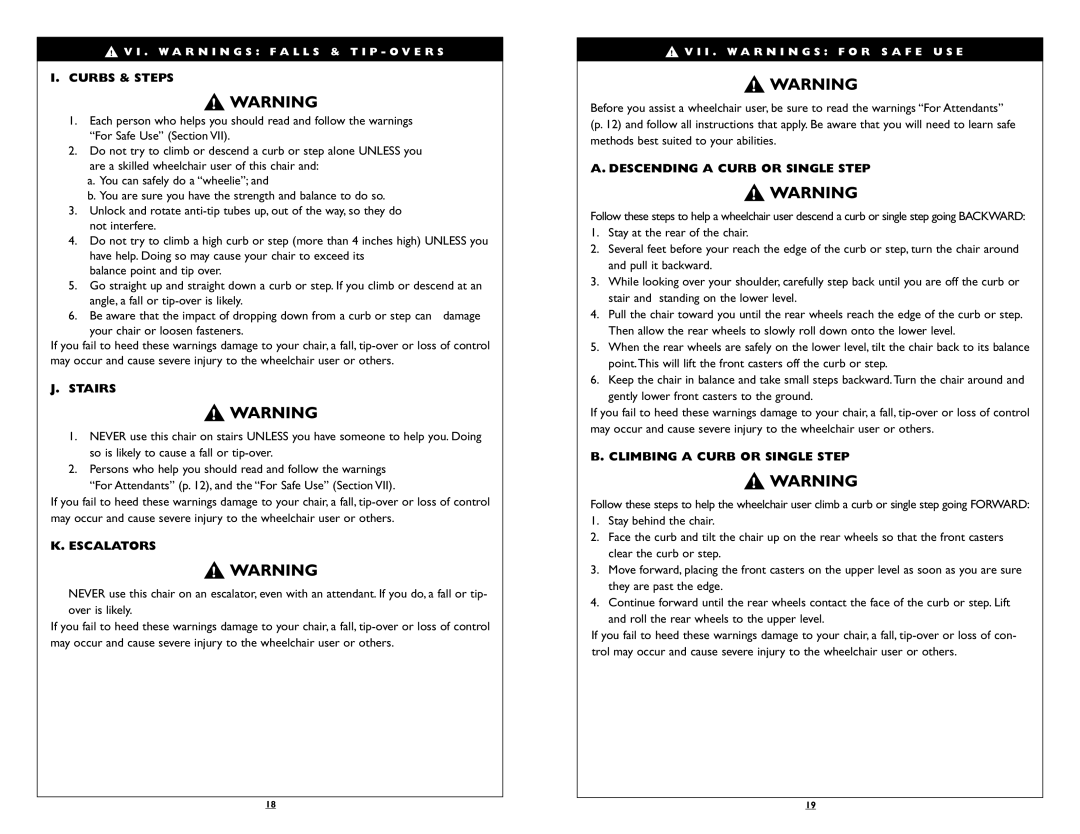
▲ | V I . W A R N I N G S : F A L L S & T I P - O V E R S |
! |
I.CURBS & STEPS
1.Each person who helps you should read and follow the warnings “For Safe Use” (Section VII).
2.Do not try to climb or descend a curb or step alone UNLESS you are a skilled wheelchair user of this chair and:
a.You can safely do a “wheelie”; and
b.You are sure you have the strength and balance to do so.
3.Unlock and rotate
4.Do not try to climb a high curb or step (more than 4 inches high) UNLESS you have help. Doing so may cause your chair to exceed its
balance point and tip over.
5.Go straight up and straight down a curb or step. If you climb or descend at an
angle, a fall or
6. Be aware that the impact of dropping down from a curb or step can damage your chair or loosen fasteners.
If you fail to heed these warnings damage to your chair, a fall,
J.STAIRS
1.NEVER use this chair on stairs UNLESS you have someone to help you. Doing so is likely to cause a fall or
2.Persons who help you should read and follow the warnings “For Attendants” (p. 12), and the “For Safe Use” (Section VII).
If you fail to heed these warnings damage to your chair, a fall,
K.ESCALATORS
NEVER use this chair on an escalator, even with an attendant. If you do, a fall or tip-
over is likely.
If you fail to heed these warnings damage to your chair, a fall,
▲! V I I . W A R N I N G S : F O R S A F E U S E
Before you assist a wheelchair user, be sure to read the warnings “For Attendants” (p. 12) and follow all instructions that apply. Be aware that you will need to learn safe methods best suited to your abilities.
A. DESCENDING A CURB OR SINGLE STEP
Follow these steps to help a wheelchair user descend a curb or single step going BACKWARD:
1.Stay at the rear of the chair.
2.Several feet before your reach the edge of the curb or step, turn the chair around and pull it backward.
3.While looking over your shoulder, carefully step back until you are off the curb or stair and standing on the lower level.
4.Pull the chair toward you until the rear wheels reach the edge of the curb or step. Then allow the rear wheels to slowly roll down onto the lower level.
5.When the rear wheels are safely on the lower level, tilt the chair back to its balance point.This will lift the front casters off the curb or step.
6.Keep the chair in balance and take small steps backward.Turn the chair around and gently lower front casters to the ground.
If you fail to heed these warnings damage to your chair, a fall,
B. CLIMBING A CURB OR SINGLE STEP
Follow these steps to help the wheelchair user climb a curb or single step going FORWARD:
1.Stay behind the chair.
2.Face the curb and tilt the chair up on the rear wheels so that the front casters clear the curb or step.
3.Move forward, placing the front casters on the upper level as soon as you are sure they are past the edge.
4.Continue forward until the rear wheels contact the face of the curb or step. Lift and roll the rear wheels to the upper level.
If you fail to heed these warnings damage to your chair, a fall,
18 | 19 |
